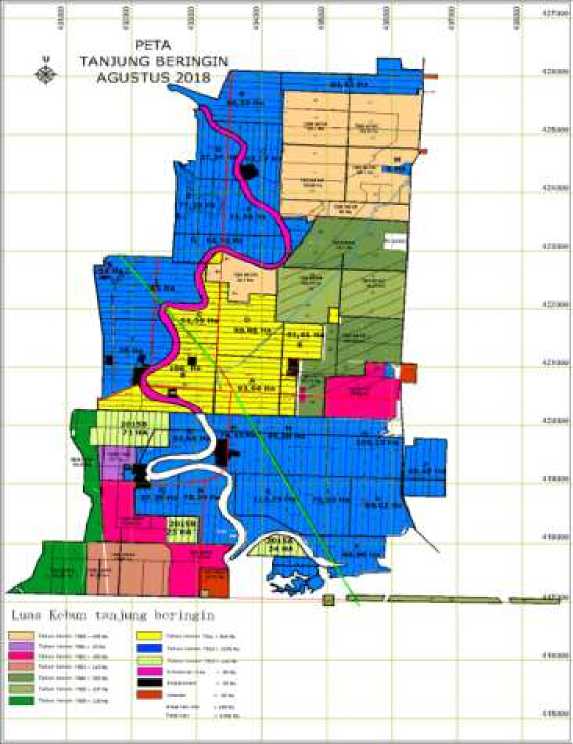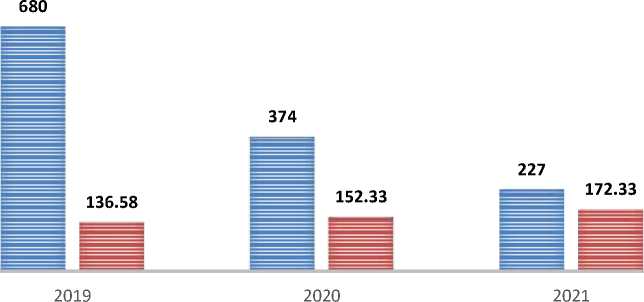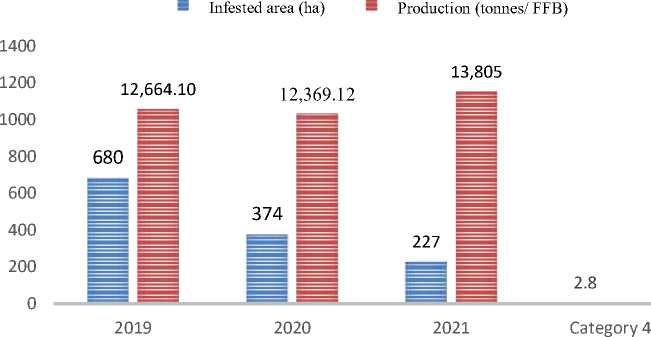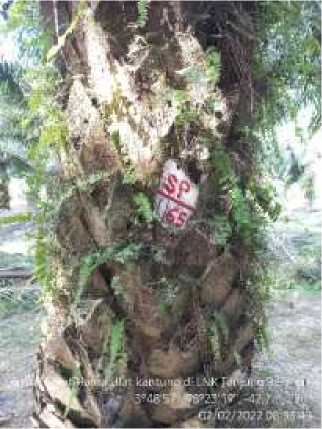The impact of bagworm (Metisa plana) attack on the production of oil palm (Elaeis guineensis Jacq.) at Tanjung Beringin Plantation PT. Langkat Nusantara Kepong
on
The Impact of Bagworm (Metisa Plana) Attacks on Oil Palm (Elaeis Guineensis Jacq.) Production at Tanjung Beringin
Plantation, PT. Langkat Nusantara Kepong, Indonesia
Arie Hapsani Hasan Basri,Stephanie Angelica Girsang, Aisar Novita
THE IMPACT OF BAGWORM (Metisa plana) ATTACKS ON OIL PALM (Elaeis guineensis Jacq.) PRODUCTION AT TANJUNG BERINGIN PLANTATION, PT. LANGKAT NUSANTARA KEPONG, INDONESIA
Arie Hapsani Hasan Basri1, Stephanie Angelica Girsang1, Aisar Novita2*
-
1 Politeknik Pembangunan Pertanian, Jl. Binjai km 10, Tromolpos No.18, Kabupaten Deli Serdang,Sumatera Utara, 20127, Indonesia
-
2 Department of Agrotechnology, Faculty of Agriculture, Universitas Muhammadiyah Sumatera Utara, Jl. Muhtar Basri No.3 Medan, Sumatera Utara, 20238, Indonesia
*Corresponding author: aisarnovita@umsu.ac.id
ABSTRACT
Received:
20 Juli 2022
Accepted:
20 September 2022
Published:
30 September 2022
Oil palm trees are widely cultivated in many places in Indonesia. However, fluctuating yields of the national oil palm production caused by several problems, such as pests and diseases. This study aimed to assess the extent and impact of bagworm (Metisa plana) attacks on oil palm (Elaeis guineensis Jacq.) production at Section III, Tanjung Beringin Plantation, PT. Langkat Nusantara Kepong, Indonesia. The data were collected from the estate office and through direct interviews, and then details on the impact of bagworm attacks were presented in tables and graphs and analyzed using descriptive statistics. This study was conducted from February to July 2022. Based on the descriptive statistics, the attacked area showed a 66.62% decrease in 2019–2021, which affected oil palm production in the subsequent years. The more area the pest infestation affects, the lower oil palm production it will cause. Throughout the years of observation, pests attacked 680 ha in 2019, causing a decline of 2.33% in the 2020 production, and 374 ha in 2020, followed by an increase of 11.60% in the 2021 production.
Keywords: Metisa plana, pest attack, oil palm production
INTRODUCTION
Indonesia was the largest palm oil producer and exporter in the international market from 2000 to 2020 (Muzakhar et al., 2014). Oil palm trees are widely cultivated in many places in the country. However, the national oil palm production tends to have fluctuating yields due to biotic factors, such as pests and diseases (Puspita et al., 2017). Oil palms (Elaeis
guineensis Jacq.) are one of the main vegetable oil-producing plants with a relatively high productivity (Adi, 2020). Oil palm plantations have an important meaning in the development of national plantations. In addition to creating job opportunities for the welfare of the community, it is also a source of foreign exchange for the country.
Environmental Conservation is a
process or method of protecting the environment from destruction and damage. To ensure the sustainable use of natural resources, it is imperative to continuously improve and maintain the their diversity values and qualities (Novita and Harahap, 2021). Indonesia is one of the largest palm oil producing countries in the world. According to the Directorate General of Plantations (2019–2021), the national palm oil production in 2019 was 47,120,247 tonnes from 14,456,611 hectares of plantations, 54.94% of which were owned by large-scale private plantations (LPPs), 40.79% were part of community plantations, and the remaining 4.27% were large-scale state plantations (LSPs). In 2020, the oil palm production increased to 48,297,070 tonnes from 14,858,300 hectares of plantations (55.76% LPPs, 40.41% community plantations, and 3.83% LSPs). In 2021, it reached 49,710,345 tonnes from 15,081,021 hectares of plantations (55.81% LPPs, 40.34% community plantations, and 3.85% LSPs).
Nevertheless, current strategies to consistently raise oil palm production are not without hurdles, especially the adverse impact of pest attacks on oil palm trees. Pest attacks are a limiting factor that damages parts of the tree, reducing the
production of fresh fruit bunches (FFB), either directly or indirectly. Direct yield losses are due to pest attacks, such as oil palm bunch moth (Tirathaba ruvifena) and rats, on flower and fruit bunches (Corley & Tinker, 2015). Decreased FFB production can also occur indirectly due to severe damage to the leaves (Woittiez et al., 2017), which disrupts the photosynthesis process and thus reduces the assimilate supply for fruit development (Ajambang et al., 2015). Damage to the leaves can also induce stress to the plants, which makes the development of male flowers more likely.
According to Priwiratama et al. (2018), the major pests attacking oil palm plantations in Indonesia are leaf borers, especially those of the Lepidoptera group like nettle caterpillars, tussock moths, and bagworms (Susanto et al., 2015). Of these three, bagworms are the most difficult to control in the field. Some dominant species in oil palm plantations are Metisa plana, Pteroma pendula, and Mahasena corbetti. PT. Langkat Nusantara Kepong (Tanjung Beringin Plantation) is a plantation company whose Section III has a land area of 768 hectares, and bagworm attacks have been reported to affect 56.34% of the area and cause a 10.24% decrease in production.
Metisa plana is the most widely spread caterpillar with extensive and severe damages in Tanjung Beringin Plantation. M. plana eats the top of the leaf, creating dry and hollow bite marks. This pest attack even occurs repeatedly in the same plantation area. Although it does not kill oil palm trees, the economic
MATERIALS AND METHOD
The research was conducted from February to July 2022 at Section III of Tanjung Beringin Plantation, PT. Langkat Nusantara Kepong, Indonesia (Figure 1). The tools used were books, stationery and laptops, and the research materials included data on the attack of bagworms (Metisa plana), oil palm production, and rainfall. To analyze these data, quantitative descriptive statistics were used. Descriptive statistics serve to describe number, values, or figures of the research object(s) through sample or population data (Sugiyono, 2019). A quantitative study is based on the philosophy of positivism, used to examine certain populations or samples, and consists of data collection using instruments and quantitative or statistical
impact is substantial (Susanto et al., 2012). For this reason, the research was designed to analyze the spread and impact of bagworm (Metisa plana) attacks on oil palm (Elaeis guineensis Jacq.) production in Tanjung Beringin Plantation, PT. Langkat Nusantara Kepong, Indonesia.
data analysis, with the aim of testing predetermined hypotheses (Sugiyono, 2016).
In descriptive statistics, data are presented in regular tables and frequency distributions, line or bar graphs, pie charts, pictograms, group explanations through mode, mean, median, and group variation through ranges and standard deviations (Sugiyono, 2019). The basic principle in presenting descriptive statistical data is thorough and communicative in the sense that it is presented to attract the attention of other parties to read and easily understand the contents. To create communicative information, data can be presented in colors and, for large data, using various types of presentation (e.g., not only tables) is encouraged (Sugiyono, 2019).

Figure 1. Map of Tanjung Beringin Area Source: PT. LNK Tanjung Beringin Area (2022)
The research procedures were as follows: selecting the location of the study, identifying the area, and identifying problems to formulate research questions. As a result, the area observed in the research was 486 hectares located at Section III, Tanjung Beringin Plantation, PT. Langkat Nusantara Kepong. Afterward, primary data were collected through open interviews to support quantitative data, while secondary data were obtained from
certain documents or formats.
In an open interview, the interviewer does not use a set of guidelines that have been systematically and completely arranged for data collection (Sugiyono, 2016). Instead, only an outline consisting of the problems surrounding the impact of the bagworm (Metisa plana) attack on oil palm production was used. This guideline was consulted throughout the interviews with the plantation assistant,
foreman I, and the pest manager. The second method, i.e., documentation, aimed to obtain data on the bagworm attack, production, and rainfall directly from the study sites through relevant books, regulations, activity reports, photographs, and assessment reports.
RESULTS AND DISCUSSION Bagworm Affected Areas
A preliminary study to determine the extent of the bagworm attack was a tree/tree census using general census or global census focusing on oil palm tree mortality in all areas at Section III, Tanjung Beringin Plantation, PT. Langkat Nusantara Kepong. Table 1 summarizes the census results from January to December 2019, in 2020, and 2021. In the last 3 years (2019–2021), the largest area affected by the bagworm (M. plana) attacks was in 2019, i.e., a total of 680 ha, with an average of 56.67 ha every month. On the contrary, the smallest one was in 2021, i.e., 227 ha with an average of
Overall, the research data included the area of the bagworm (Metisa plana) attack in 2019, 2020, and 2021, oil palm production in 2020 and 2021, rainfall data in 2019 and 2020, and interview results, which were analyzed using descriptive statistics.
18.92 ha per month. The widely spread infestation of bagworms in 2019 was due to the relatively low rainfall of 1,639 mm in this year, which created a favorable environment for their breeding. The same case was found in February, which received 75 mm rainfall in 2019 (pest-affected area = 34 ha) and a lower rainfall, 52 mm, in 2020 (wider affected area = 55 ha). On the contrary, February 2021 received a higher rainfall, 58 mm, decreasing the pest-affected area to 20 ha. These results correspond to Anggraini and Purba (2021), which stated that a relatively low rainfall allows bagworms to proliferate, whereas a high one impedes breeding.
Table 1. Areas affected by bagworm attacks at Section III, Tanjung Beringin Plantation, PT. LNK, 2019–2021
|
Affected Area 2019 |
Affected Area 2020 |
Affected Area 2021 | |
|
N Valid |
12.00 |
12.00 |
12.00 |
|
Missing |
0.00 |
0.00 |
0.00 |
|
Mean |
56.67 |
31.167 |
18.91 |
|
Minimum |
0.00 |
0.00 |
0.00 |
|
Maximum |
108.00 |
59.00 |
29.00 |
|
Sum |
680.00 |
374.00 |
227.00 |
800
700
600
500
400
300
200
100
0
= Infested area (ha) ■ Rainfall (mm)

Figure 2. Rainfall data and Metisa plana-infested areas at Section III, Tanjung Beringin Plantation, PT. LNK, 2019–2021
Figure 2 shows that the bagworm attacks affected fewer areas at Section III, Tanjung Beringin Plantation, PT. LNK, from 2019 to 2020. A decrease of 453 ha was observed. On the contrary, throughout these years, there was an increasing trend in the rainfall, i.e., by 429 mm. In details, from 2019 to 2020, the area where bagworm attacks had been reported decreased by 306 ha (45%). Based on the interview results, the decrease was presumably because 2019 saw a relatively high rainfall (1,828 mm) and a new pest control using the trunk injection method or systemic toxins was introduced in 2020.
Pesticides belonging to the systemic toxin group work periodically. The active ingredients contained in systemic pesticides will enter the plant through the roots, stems,
and leaves and then spread throughout the plant tissue. This way, pests will ultimately die after eating the “poisoned” plant parts. Systematic toxin application has its own advantages, including effectiveness in controlling pests that may hide between plants, such as bagworms. According to Harianja et al. (2018), the use of the pesticide Acephate (systemic toxin) can reduce bagworm populations in oil palm plantations. Continuous use of pesticides can increase pest resistance to the applied toxins but, on the other hand, can decrease the population of pests susceptible to them (Ishartadiati, 2017). The bagworm population control at Section III in 2019 and the previous year used contact poison by spraying. Pesticides in this category will be directly absorbed through the skin at the
time of administration, creating a toxic environment to pests. However, this method has its own weaknesses, including its inability to control pests 100%. It means that only pests that are exposed to this poison during its application will die, while the unexposed will not.
Throughout the years of observation, bagworms attacked the least area at Section III in 2021. The bagworm attacks decreased by 306 ha (45%) in 2019–2020 and then by 147 ha (39.30%) in 2020–2021. The year 2021 saw a relatively high rainfall of 2,068 mm, and it decreased the bagworm population because the pests could rarely survive and might be washed away by heavy rain. Moreover, a high rainfall is
Impacts of Bagworm Attacks on Oil Palm Production
In nature, bagworms are part of an ecosystem, but they can turn into pests in a monoculture system (growing only one crop species) that has suboptimal bagworm population control, compared with polyculture system. Pest infestation likely leads to considerable losses of production and quality degradation. To achieve optimal production, it is necessary to understand the characteristics and factors that can hinder production and seek appropriate solutions. There have been various challenges in
often associated with a low temperature. Pests can survive, breed, and multiply in a certain range of temperature. Metisa plana can grow at 25 to 30°C. Outside this ideal temperature range, pests will either freeze to death or overheat. Based on the interview results, Section III continued to apply the stem injection in 2021 because it had proved successful in reducing the bagworm population. This is in line with Wahyuni et al. (2017), which confirmed the effectiveness of the stem injection system in reducing bagworm attacks. Similarly, Manengkey (2021) also stated that stem injection is an effective and efficient pest population control strategy.
increasing oil palm production at Tanjung Beringin Plantation, PT. LNK, including bagworm (Metisa plana) infestations. According to Agustina (2021), this bagworm attack can decrease oil palm production by up to 40% and even severely damage and kill oil palm trees. Section III produced 12,664.10 tonnes of FFB/year in 2019, and this number increased to 12,369.12 in 2020 and 13,805 tonnes of FFB/year in 2021.
Table 2. Fresh Fruit Bunches (FFB) Production at Section III, Tanjung Beringin Plantation, PT. LNK, 2019–2021
|
Month |
Production (tonnes/FFB) | ||
|
2019 |
2020 |
2021 | |
|
January |
959.19 |
718.40 |
916.10 |
|
February |
840.52 |
746.90 |
800.69 |
|
March |
920.20 |
767.12 |
1,066.84 |
|
April |
896.77 |
1,160.92 |
1,255.68 |
|
May |
756.50 |
1,169.52 |
1,194.12 |
|
June |
1,167.61 |
1,160.35 |
1,372.77 |
|
July |
1,323.49 |
1,458.45 |
1,194.82 |
|
August |
1,368.56 |
1,359.57 |
1,486.34 |
|
September |
1,232.58 |
1,223.58 |
1,384.69 |
|
October |
1,127.72 |
825.99 |
1,085.51 |
|
November |
1,029.16 |
992.38 |
1,081.25 |
|
December |
1,041.83 |
785.94 |
966.19 |
|
Total |
12,664.10 |
12,369.12 |
13,805 |
|
Average |
1,055.34 |
1,030.76 |
1,150.42 |
The data in Table 2 show that in 2019 the highest production was in August (1,368.56 tonnes/FFB) and the lowest one in May (756.50 tonnes/FFB). The average production in 2019 at Section III was 1,055.34 tonnes/FFB. In 2020, the highest production was in July (1,458.45 tonnes/FFB) and the lowest one occurred in January (718.40 tonnes/FFB). The average production of this year was 1,030.76 tonnes/FFB. In 2021, the production ranged from 800.69 tonnes/FFB in February to 1,486.34 tonnes/FFB in August, with an average production of 1150.42 tonnes/FFB.
-
Figure 3 shows FFB productions at Section III in 2019–2021. In 2020, the
plantation produced the lowest fruit bunches (12,369.12 tonnes/FFB) with an average of 1,030.76 tonnes/FFB per month, which decreased by 2.33% from the 2019 production. This harvest decline was due to the extensive, severe bagworm infestations in 2019, which affected about 680 ha of the plantation area. Bagworms defoliate and damage leaves, which then disrupt their function in photosynthesis and hampers the tree growth and fruit formation (Hosang et al., 2012). In addition, Widodo et al. (2018) confirmed that the more extensive the bagworm infestation is, the lower the production will be.

Figure 3. Oil palm productions at Section III, Tanjung Beringin Plantation, PT. Langkat Nusantara Kepong, 2019–2021 (in tonnes/ FFB)
In 2021, oil palm FFB production increased to 13,805 tonnes/FFB, with an average of 1,150.42 tonnes/FFB per month. It was 11.61% higher than the 2020 production, which was attributable to the decline in the bagworm population in 2020 due to the adoption of stem injection (systemic toxin) as pest control. Based on the interview results, the FFB production at Section III had increased since the stem injection method was implemented. This finding corresponds to Rangkaya et al. (2021), which also stated that the stem injection method (systemic toxin) effectively reduced pest population and, afterward, plant production would slowly increase.
Other factors responsible for the increase in oil palm production are superior plant varieties and balanced fertilization. The initial key to the success
of plant cultivation is to increase oil palm production, which can be achieved using certain plant varieties. Section III grew Topaz 1, which is the crossbreeding result between Deli Dura and Pisifera from Nigeria. Topaz 1 is the most popular variety among oil palm plantation companies due to its higher yield and adaptability to soil conditions. This is especially true because Topaz 1 produces more female flowers that can produce fruit. Plant nutrients can be obtained from nature from organic decay and mineral weathering, but, oftentimes, in a very limited amount. These limitations can be overcome by additional nutrients or fertilizers. According to Triyanto (2017), fertilization aims to provide sufficient nutrients to encourage vegetative growth and increase oil palm production and resistance to pests and diseases. Section III
applied fertilizers in accordance with the Standard Operating Procedure (SOP) set by the company.
-
Figure 4 shows a damaged oil palm tree due to bagworm (Metisa plana) attack that disrupted the formation of fresh fruit
bunches. Effective pest control and proper handling can reduce the bagworm population (Pahan, 2008). With proper control, oil palm trees produce fresh fruit bunches, which will gradually raise the overall production.

Figure 4. Bagworm infestations damaging oil palm trees
CONCLUSIONS
Bagworms (Metisa plana) infected oil palm trees at Section III, Tanjung Beringin Plantation, PT. Langkat Nusantara Kepong, Indonesia, in 2019– 2021. The affected area, however, decreased by 66.62% or 453 ha throughout these years. In details, bagworms were found in 680 ha in 2019, 374 ha in 2020, and 227 ha in 2021. The substantial decrease in the affected area in 2020 was because the company introduced the stem injection method as part of its pest control
and management. Bagworm attacks affect oil palm production. An extensive infestation would likely lead to lower production. Bagworms were spread in 680 ha of the plantation area in 2019, causing a production decline of 294.98 tonnes of FFB/year (2.33%) in 2020. Meanwhile, the affected area in 2020 was 374 ha, thus increasing the 2021 production by 1,435.88 tonnes of FFB/year (11.60%). From these figures, it can be inferred that pest control by stem injection is effective in reducing bagworm populations and
increasing the production of oil palm (fruit
fresh bunches).
REFERENCES
Adi, P. (2020). Kaya dengan Bertani Kelapa Sawit. Pustaka Baru Press, Yogyakarta.
Agustina, N. A. (2021). Tingkat Serangan Hama Ulat Api Setothoseaasigna dan Hama Ulat Kantung Metisa plana pada Perkebunan Kelapa Sawit Elaeis guineensis Jacq di PTPN IV Unit Usaha Bah Birung Ulu. Jurnal Ilmiah Rhizobia, 3:1, 50-57.
Ajambang, W., Ardie, S. W., Volkaert, H., Galdima, M., & Sudarsono, S. (2015). Huge carbohydrate assimilates delay response to complete defoliation stress in oil palm (Elaeis guineensis Jacq.). Jurnal Food Agr, 27:1, 126-137.
Anggraini, S., Purba, R. P. (2021). Tingkat Serangan Ulat Api (Setothosea asigna van Eecke) Pada Kelapa Sawit Kategori Tanaman Menghasilkan (TM) PTPN IV Unit Usaha Kebun Bah Birung Ulu. Jurnal Pertanian Berkelanjutan, 9:3, 208-213.
Corley RHV & Tinker PBH. (2015). The Palm Oil. Ilmu Blackwell, Oxford.
Direktorat Jenderal Perkebunan. (2019). Rencana Strategis Pembangunan Perkebunan 2019-2021, Kementerian Pertanian RI.
Harianja, Y. R., Sitepu, S. F., Marheni., Prasetyo, A. E., & Rossiansha. (2018). Dampak Penggunaan Pestisida
Insektisida Sistemik terhadap
Perkembangan Serangga Penyerbuk Kelapa Sawit Elaeidobius kamerunicus Faust (Coleoptera: Curculionidae).
Jurnal Agroekoteknologi, 6:2, 330-338.
Hasibuan, Syafrizal. (2019). Hama Penting Tanaman Perkebunan dan Metode Pengendalian. Gema Ihsani, Deli Serdang.
Hosang, M. L. A., Aloue, J. C., & Laba, I. W. (2010). Pengujian Lapangan
Insektisida Monosultap 400 SL
Terhadap Hama Sexava nubila pada
Tanaman Kelapa. Buletin Palma, 30: 162-171.
Ibrahim, Y., Tuck, H. C., Chong, K. K. (2013). Pengaruh Suhu terhadap Perkembangan dan Kelangsungan Hidup Ulat Kantung Pteroma pendula dan Metisa plana (alaepidoptera: Psychidae). Jurnal Penelitian Kelapa Sawit, 6:1, 51-59.
Indiati, S. W., Marwoto. (2017). Penerapan Pengendalian Hama Terpadu (PHT) pada Tanaman Kedelai. Buletin Palawija, 15:2, 87-100.
Ishartadiati, K. (2017). Resistensi Serangga terhadap DDT. Universitas Wijaya Kusuma, Surabaya.
Manengkey, T. M., Meray. E. R. M., & Rante, C. S. (2021). Pengendalian Hama Penggerek Batang Cengkih (Hexamitodera semivelutina Hell.) Menggunakan Insektisida Fipronil dan Emamektin Benzoat dengan Metode Injeksi Lubang pada Batang. Jurnal Cocos. 7:7.
Muzakhar, K., Sutoyo and Siswoyo. 2014. Sugar Production by Digesting of Oil Palm Empty Fruit Bunch Using Extracellular Enzymes from
Aspergillus niger and Trichoderma reesei for Ethanol Production. International Journal of Biosciences and Biotechnology. Vol 2, No. 1.
Nurindah.( 2006). Pengelolaan
Agroekosistem dalam Pengendalian Hama. Perspektif Review Penelitian Tanaman Industri, 5(2), 78-85.
Novita, A and Harahap, I. M. S. (2021). Kelestarian dan Kesehatan Lingkungan Desa Hutaimbaru Kecamatan
Halongonan Kabupaten Padang Lawas Utara. Martabe Jurnal Pengabdian Kepada Masyarakat. 4(3). ISSN 25981226.
Pahan, I. (2008). Panduan Teknis Budidaya Kelapa Sawit. PT. Indopalma Wahana Hutama, Jakarta.
Paiman. (2019). Teknis Analisis Korelasi dan Regresi Ilmu-Ilmu Pertanian. UPY Press, Yogyakarta.
Priwiratama, H., Rozziansha, T. A. P., & Prasetyo, A. E. (2018). Efektivitas Flubendiamida dalam Pengendalian Ulat Api (Setothosea asigna van Eecke), Ulat Kantung (Metisa plana Walker) dan Penggerek Tandan (Tirathaba rufivena Walker) serta Pengaruhnya Terhadap Aktivitas Kumbang Penyerbuk (Elaeidobius kamerunicus Faust). Jurnal Pen. Kelapa Sawit. 26:3, 129-140.
Priwiratama, H., Rozziansha, T. A. P., Prasetyo, A. E., & Susanto, A. (2019). Effect of Bagworm Pteroma pendula Joannis Attack on The Decrease in Oil Palm Productivity. Jurnal HPT Tropika. 19(2), 101-108.
Puspita, F., Hadiwiyono., Porpmorto, S.H and Roslim, D.I. (2017). Morphology, Physiology and Molecular
Characteristics of Oil Palm (Elaeis guineensis Jacq.) Endophytic Bacillus sp. International Journal of Biosciences and Biotechnology. Vol. 5 No.1. ISSN: 2303-3371.
Quadratullah, M. F.(2014). Statistika Terapan: Teori, Contoh Kasus dan Aplikasi dengan SPSS. CV Andi Offset, Yogyakarta.
Rangkaya, A., Lengkong, M., Rante, C. S., & Kaligis, J. B. (2021). Tingkat Kerusakan dan Padat Populasi Hama Sexava coriacea L. pada Tanaman Kelapa di Desa Tongutesungi Kecamatan Ibu Kabupaten Halmahera Barat. Jurnal Cocos. 2:2.
Sugiyono. (2016). Metode Pengkajian
Administrasi. CV Alfabeta, Bandung.
Sugiyono. (2019). Statistika untuk Penelitian. CV Alfabeta, Bandung.
Susanto, A., Prasetyo, A.E., Priwiratama, H., Rozziansha, T. A. P., Simanjuntak,
D., Sipayung, A., Widi, A. T., Purba, R. Y., Sudharto, & Chenon. R. D. d. (2015). Kunci Sukses Pengendalian Hama dan Penyakit Kelapa Sawit. Pusat Penelitian Kelapa Sawit, Medan. Susanto, A., Prasetyo, A.E., Priwiratama, H., Rozziansha, T. A. P., Simanjuntak, D., Sipayung, A., Widi, A. T., Purba, R. Y., Sudharto, & Chenon. R. D. d. (2012). EWS: Ulat Api, Ulat Kantong, Ulat Bulu. Pusat Penelitian Kelapa Sawit, Medan.
Triyanto, Y. (2017). Pengaruh Tingkat Pemupukan dan Harga Jual Tandan Buah Segar (TBS) terhadap Produksi dan Pendapatan Usaha Tani Kelapa Sawit Rakyat Kabupaten Labuhanbatu. Jurnal Agroplasma (STIPER)
Labuhanbatu. 4(2), 6-11.
Wahyuni, M., Sinaga, M. A., Restua, S. 2017. Efektivitas Pengendalian Hama Ulat Kantung (Metisa plana) pada Tanaman Kelapa Sawit (Elaeis guineensis Jacq) dengan Sistem Injeksi Batang di Kebun Tanjung Garbus PT. Perkebunan Nusantara II. Jurnal Agro Estate. 1:2, 104-110.
Wardani, N. (2017). Perubahan Iklim dan Pengaruh Terhadap Serangga Hama. Disajikan dalam Seminar Nasional Agroinovasi Spesifik Lokasi untuk
Ketahanan Pangan pada Era
Masyarakat Ekonomi ASEAN di
Bandar Lampung, Oktober 2017.
Widodo, P., Wijaya, I. M. A. S., Budisanjaya, I. P. G. (2018). Hubungan Antara Persentase Serangan Hama Tikus dengan Produktivitas Lahan Melalui Pendekatan Foto Udara. Jurnal Beta (Biosistem dan Teknik Pertanian). 6(2), 90-97.
Woittiez, L. S., vanWijk, M. T., Slingerland, M., vanNoordwijk, M., & Giller, K. E.(2017). Yield gaps in palm oil. Jurnal Agron. 83, 57-77.
12
Discussion and feedback